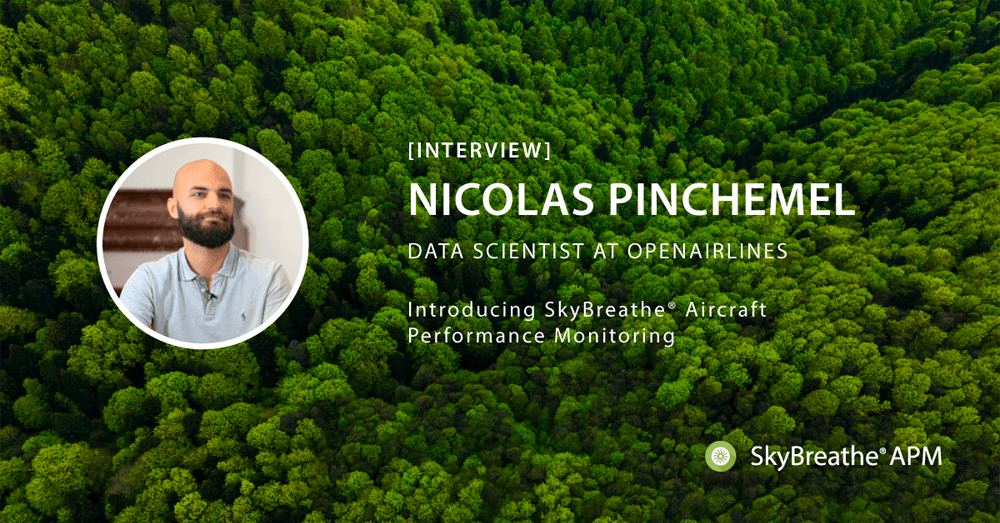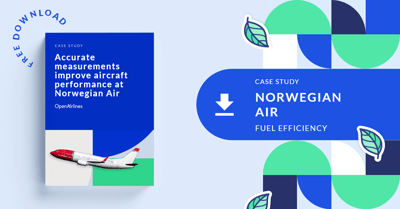[Interview] Introducing SkyBreathe® Aircraft Performance Monitoring
Interview of Nicolas Pinchemel, Data Scientist at OpenAirlines.
A few words about his background: Nicolas Pinchemel has been a data scientist at OpenAirlines for three years.
He specialized in flight data analysis and cruise aircraft performance.
He has been working on APM performance computation for the last three years.
Why monitor aircraft performance?
Airlines monitor aircraft performance to have more accurate flight plans and better Flight Management System (FMS) fuel estimations. Fuel estimations are computed using a fuel factor to account for the individual performance of the specific aircraft.
Therefore, having an accurate fuel factor is paramount for flight safety. It also increases pilot trust in the estimation given by the systems, which often leads to reducing pilot discretionary extra fuel.
Related Article >> How to reduce pilot extra fuel without compromising safety?
The most advanced aircraft performance monitoring (APM) processes also help detect root causes of aircraft deterioration and take proactive maintenance actions to improve aircraft performance as quickly as possible.
What are the problems airlines are facing today?
At most airlines, aircraft performance monitoring relies on manual processing of cruise reports using multiple OEM software solutions that are tedious to use. It takes hours or even days to process the whole fleet. Having one piece of software per aircraft manufacturer in the fleet makes it harder to understand and compare the performance figures. It gives little time to analyze actual performance, and airlines can only compute a new fuel factor every month at best. Most of the time, they have limited resources to understand aircraft performance degradation and may not even fully trust their current aircraft performance results.
What is SkyBreathe® Aircraft Performance Monitoring?
SkyBreathe® APM is a software dedicated to Aircraft Performance monitoring and part of the SkyBreathe® 360° eco-flying platform.
It processes QAR data every day to extract cruise stable data points to evaluate the latest aircraft performance. It recommends a new fuel factor based on aircraft performance history and according to airline policies.
Related Article >> How to monitor aircraft performance degradation with accuracy?
SkyBreathe® APM automatically delivers insights for each aircraft to grasp which ones suffer from abnormal deteriorations worth investigating quickly. It also tells which part of the aircraft causes performance variation, whether from an engine deterioration or a surface misrigging.
How does it work?
Everyday QAR data for all aircraft types are automatically processed to compute performance figures. These are available for performance engineers right after to analyze them and produce the latest fuel factor recommendation.
SkyBreathe® APM gives an overall performance of the fleet and detailed performance analyses for each aircraft. To further understand aircraft performance, the users may also go deeper by creating their own queries to analyze numerous flight parameters like fuel flow, N1, or aircraft surface positions.
How is aircraft performance calculated?
The aircraft performance is computed using as many stable records as possible during cruise. The actual recorded performance of the airplane is then compared to the baseline performance of its aircraft type, also called “book values” for each of the cruise records. These deviations are aggregated to get reliable numbers of aircraft, airframe, and engines performance for each aircraft. The fuel factor is then computed based on recent aircraft performance and considering airline policies on fuel factor update.
How to set up an APM process?
SkyBreathe® APM allows having the same process for any aircraft type. The data ingestion and the fuel factor recommendations are automatically made, so the performance engineer must only retrieve the newly computed fuel factor. It is also possible to set up alerts to get the new fuel factors when available to make the process even more seamless.
How does SkyBreathe® APM make airlines save fuel?
SkyBreathe® APM helps save fuel by having a more up-to-date fuel factor, more frequent updates, and more accurate computations.
It is also a powerful tool to detect root causes of performance degradation, take proactive maintenance actions, improve the aircraft’s general condition, and always maintain its fuel efficiency at its highest level.
To know more about APM benefits here is an interesting article to continue your reading.
Try by yourself SkyBreathe® APM features and discover how it can bring high benefits in terms of cost reduction and fuel burn in your airline.
LEARN MORE
[CASE STUDY] See how Norwegian leverages data analytics to improve its APM process.
>> Download the free case study




